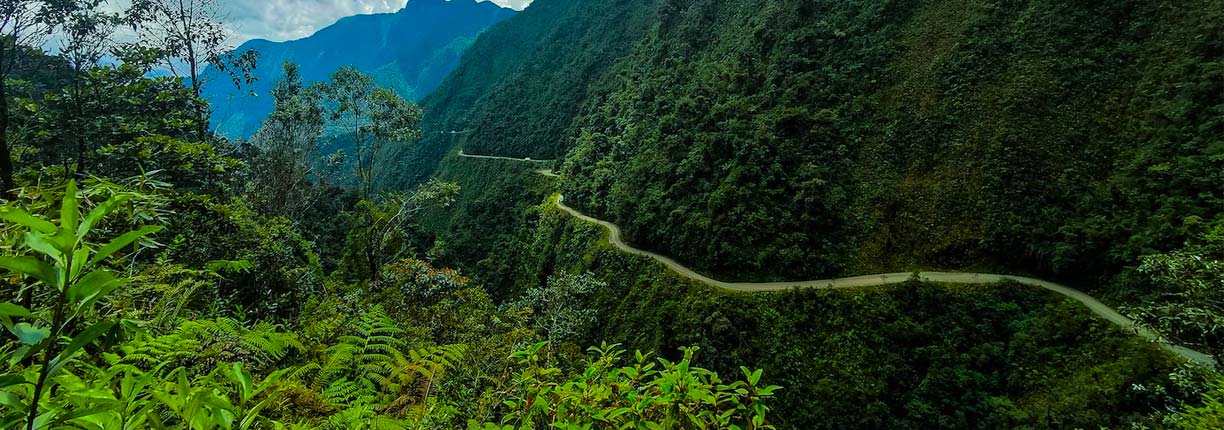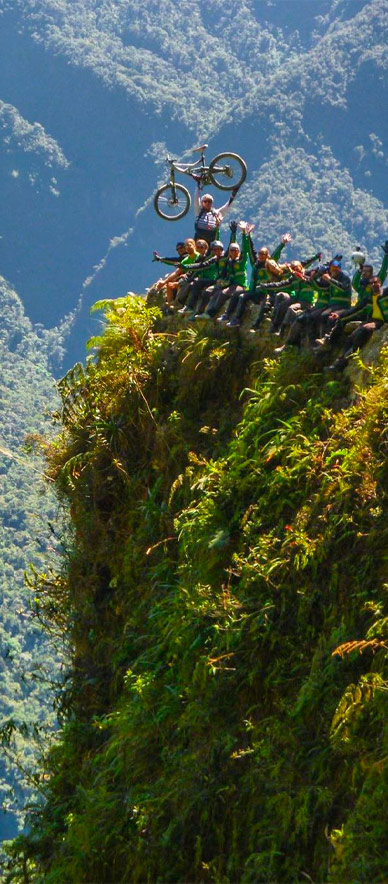Death Road Tours: Everything you need to know about the Death Road, the world’s most dangerous road, from how to get there, what company to go with and more!
Death Road Tours
Suitable for most skill levels
All operators offer daily departures
Price: From $80 USD - Prices differ from operators
Click any link to go direct to that section or scroll down to read the whole guide

Death Road, also known as Yungas Road, stretches for a little more than 60kms
Death Road in La Paz Bolivia is the name given to official most dangerous road in the world, Yungas Road. This road stretches about 61 km, and covers La Paz to Coroico. It was officially named the world’s most dangerous road in 1995, with an estimated 200 to 300 people killed on this road every year.
In recent years, this has become a major tourist attraction in La Paz, with people wanting to get their t-shirt that says “I survived my ride on the world’s most dangerous road” as downhill mountain biking tour companies take advantage of tourists need for adventure and adrenalin rushes!
However, do not be alarmed by its title…although the Death Road definitely needs to be respected, it has become much safer in recent years. Traffic has been stopped on many parts of the road to give cyclists a fun and safe trip. What is not so safe is that there are some cheap tour operators in La Paz who use bad bikes. These might not regularly maintained or the brakes may not be regularly checked, so be very careful of which company you choose when taking a tour down the Death Road.
Bolivia Hop has partnered up with Gravity Biking in recent months due their focus on safety matching the levels we demand for our passengers. We feel that they and Altitude Biking are the 2 safest bike companies on the Death Road. We have been able to negotiate a small discount off all tour prices for Bolivia Hop passengers, meaning that you can get the safest and most enjoyable Death Road experience at an incredible price! Speak to your onboard guide on your bus to La Paz or go to our office in La Paz.
07:00am
Pick ups from the meeting point or your hotel, with the guides and everything you need for this adventure. Start from the city of La Paz, which is at a height of 3,600 meters (11,810 feet), to the foot of the Andes Mountains or Cordillera Real. Towards the summit which is 4,700 m (15,420 feet) out of the city of La Paz, appreciate the desert flora and fauna of the plateau and the snowy mountains of the Cordillera Real.
09:00am
Proceed to get the specialized equipment for this adventure. The guides make recognition of the teams to make sure everything is secure then very attentively hear the explanations of them as you have a hot snack.
10:00am
Bike adventure starts. The first part is asphalt with a very frigid weather to reach the population Unduavi (narcotics and revision control, motorized transport only). Short break with a mid-morning snack.
10:30am
Dirt road begins at a height of 2,700 meters (2,953 feet) above sea level. In the beginning of the Bolivian jungle, exactly where the paved road ends, begins the most dangerous road in the world. This dirt road with an amazing view will be an adventure nonetheless. Along with the guides you will carefully go down going through rivers, waterfalls, along with the wide variety of flora and fauna.
12:30pm
Time for a break of 20 minutes with some refreshments.
1:45pm
Arrive at the bridge, a place with warm weather and the end of our cycling adventure at 1,200 m ( 3,940 feet ). Move the HOTEL VILLA VERDE 5 minutes from Coroico, where you can shower, have lunch, and enjoy the good weather by the pool.
2:30pm
Return to the city of La Paz on our new road transport. It is a very safe to 2-lane, downstream and upstream, called Cotapata Santa Barbara.
6:00pm
Arrival to La Paz.

With professional equipment, a positive attitude, listening to expert instruction, coaching and supervision, you can safely enjoy some of South America’s most dramatic and beautiful scenery as you hurtle down the road. On top of that, you should note that since March 2007 the majority of traffic has stopped driving down the Death Road, and now drives down a new road … leaving the Death Road for riders to enjoy without battling many trucks, buses and cars! Of Course, before the actual start of the tour you will get the chance to practice using your mountain bike. If you are really nervous and no longer want to complete the trip on a bike – you can always jump on the bus which travels behind the group all the way to the bottom.
From beginning of December until the end of February there is the rainy season in Bolivia. If you can, you should try to do the ride outside of that season. If you cannot change your travel itinerary you can still do the trip! Rain does not stop the tour from going ahead unless it is so bad that the guides consider it to be too dangerous – we have not known this to happen ever. If things get muddy, of course that can slow things down but it does not stop the trip from going ahead. You cannot decide to cancel the day of because you don’t want to get wet, sorry! The provided trousers and jacket are splash/wind proof so please do bring a raincoat during wet season.
You will pass through small waterfalls and streams and since there is a lot of mud and dust on the road, you must bring a change of clothes. For at the top, in the morning, don’t forget some warm clothes. The tour starts at a cold area 4700 meters (15,420 feet) above sea level, closed-toe shoes (no flip-flops), raincoat in wet season, sunglasses, sunscreen, mosquito repellent, and bathing clothes.
Yes. Please note that the Municipality of Coroico introduced a charge for bikers riding the “World’s Most Dangerous Road”, it is 50 Bs now – 25 Bs at the start and 25 Bs at the end of the road. The money raised from this entrance fee will be used to fund much needed infrastructure projects such as: clean public toilets on the route, road maintenance (since the road is not used by much traffic now, without this fee it could be closed without maintenance), safety, emergency and rescue facilities.
Altitude have a group of mechanics who maintain the bikes on a daily basis. A mechanic will also go on every tour so if anything should go wrong we have someone who can fix the issue or we give you a replacement bike. Altitude offers 2 types of bikes with the variance in the bikes that have to do with suspension. The better the suspension the more comfortable you will be as Death Road is a bumpy, gravel road.
Yes, you will need to provide your insurance details. If you do not have insurance, they can provide you with insurance for the duration of the day trip for an additional fee ($38).
You will be provided with a bottle of water and 2 snacks on the trip. Plus there is also a buffet lunch at the end. You can bring additional water and snacks if you wish.
The operators provide all the necessary equipment you need. This includes: full face helmets, gloves, knee and elbow pads along with the jacket and trousers.